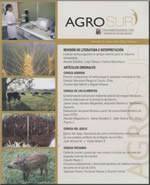RELATIONSHIP BETWEEN THE NEMATOFAUNA AND SOIL MANAGEMENT HISTORY IN FRUIT ORCHARDS
Main Article Content
Abstract
The objective of this study was to differentiate sites influenced by long-term application of synthetic fertilizers, herbicides and tillage, using the percentages of nematode trophic groups and ecological indices on fruit orchards. The experiments were conducted in Upper Río Negro Valley, on medium texture soils. Seven sampling sites were established. Soil samples were collected in October, for two consecutive years. Main component analyses were performed. The distribution of the sites, according to the percentage of trophic groups (bacterivores, fungivores, plant feeders and omnivores-predators) and community indices of nematodes (MI, PPI, EI and SI) showed a different pattern of arrangement. Each long-term soil management supported different nematode assemblages. The plant-parasitic nematodes were the most abundant group in sites fertilized with nitrogen and under application of herbicide for at least ten years. The percentage of fungivore nematodes was higher in soils subjected to application of herbicides, no fertilizers and no tilling. Soils with a similar assemblage of nematodes, expressed in percentages of trophic group, did not necessarily presented a similar functional condition of the throphic web. The interpretation of the studied parameters can provide useful information about the nutritional status and ecological health of the soil in fruit orchards.

